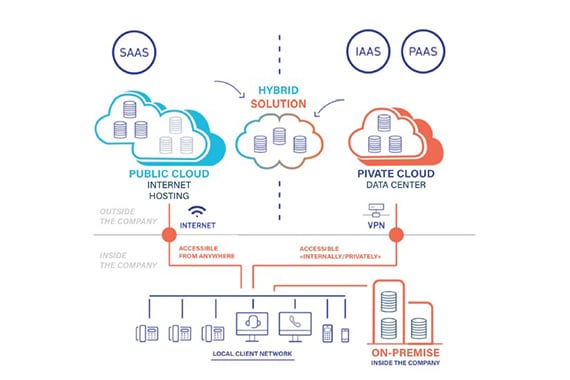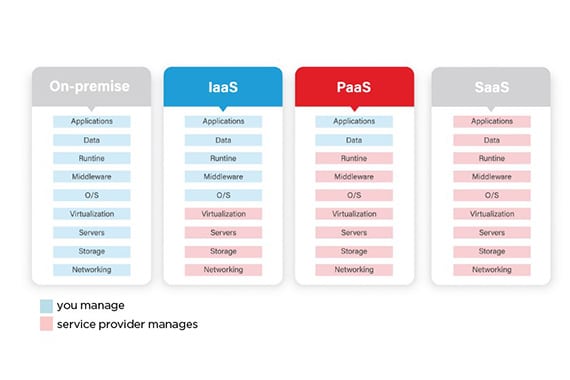What is cloud computing?
Cloud computing consists in providing computing resources and services (servers, databases, storage space, etc.) over the Internet rather than a local server.

Already very promising, cloud computing’s growth has recently been given a boost by the democratization of remote working, e-learning, e-commerce and video streaming.
Its functional and economic character is attracting an increasing number of businesses who love it for its many advantages, even to the point of making it a decisive criterion in consultations for supply chain execution software.
These new standards are leading CIOs to ask themselves many questions, such as, «Should we lease or buy the applications?» «What is the amortization?» «What mode of cloud computing?» «What are the benefits, and what are the drawbacks?».
Now, the question is no longer, «Should we adopt cloud computing?» but rather, «What model should we build to suit our needs?»

Cloud computing consists in providing computing resources and services (servers, databases, storage space, etc.) over the Internet rather than a local server.
using the cloud removes the need for many investments in hardware and software. Cloud computing does not require you to buy a server and assume the costs that come with it, such as electricity consumption and IT teams dedicated to managing and maintaining these infrastructures.
cloud computing allows you to access your application or data from anywhere as long as you have internet access.
Cloud computing providers are able to offer their clients much higher levels of application and infrastructure security than simple enterprise servers that are hosted locally.
These benefits, as well as the economies of scales that they generate, explain the growing popularity of cloud computing among businesses. Estimates are showing that 2/3 of the world’s data will be stored in a cloud-based solution by 2025. In this vein, the Gartner study expects the global market of public cloud computing services to increase by 17% in 2020, reaching $266.4 billion, compared to $227.8 billion in 2019. The spread of 5G should boost cloud computing’s adoption rate by significantly reducing problems of latency and the fears of slowdowns related to the use of remote resources by a growing number of users.
On the other hand, like for any kind of outsourcing, the design and contractualization of this type of service will require you to be vigilant. It is important that you ask yourself the right questions in order to keep control over what gives your company IT value: data. Where are they? In which country? Subject to what legislation? How and how often are they backed up? How can you retrieve them? Who accesses them? Why? You will need clear, precise answers before you can look at using cloud computing with peace of mind.
Cloud computing can take various forms: private, public, or hybrid.
To choose the right type of cloud computing, you will need to take a look at your sector of activity and the nature of the data that will be stored (are they sensitive? are they subject to professional secrecy or special legislation?).

Private cloud refers to a private infrastructure entirely dedicated to the company and its users and located on private servers. Whether hosted internally or remotely in a data center, a private cloud comes the closest to local infrastructure. It is billed based on service criteria such as the type of server used and its power, the maintenance service, and the number of users.
The private cloud is often the preferred mode of companies with sensitive data that is subject to a high level of inspection. This is the case for public organizations and finance, for example.
Private organizations have many benefits, the first of which is total confidentiality due to the lack of shared infrastructure and resources. Private clouds also offer a greater ability to customize the environment to suit the company’s needs and business constraints.
The public cloud is probably the most popular mode. In this type of cloud, the company’s data is hosted on a multitude of servers accessible to a set number of users (those from your company).
The resources are shared between the supplier’s various clients, which explains why it is fast and affordable to set up. Its cost will take into account the number of users and the volume of data stored and used.
The advantages of the public cloud are, first, its price, because you save by not buying hardware or software and only pay for what you use. You also do not have to pay for maintenance, which is your supplier’s responsibility. Replicated in several data centers, the public cloud is very reliable. Its architecture helps to prevents outages and data loss.
This mode of cloud combines the benefits of the two other modes: the reliable and secure side of the private cloud and the flexible and accessible aspects of the public cloud. This way, a company can build a hybrid cloud solution when it wants to spread its application or data between the public and private cloud. Connected by a technology, the data or applications can be exchanged between the public and private cloud in a flexible, secure way. For example, a company may want to keep its client data in the private cloud to keep them secure and place a web front-end in the public cloud to take advantage of advanced computing capacity (for Black Friday and Christmas sales, for example).
As explained, the hybrid cloud has many advantages, especially for companies looking for agility in terms of volume or computing and processing performance. It can also suit organizations who want to process certain types of data separately according to their degree of sensitivity.
We can count three main cloud computing services, each offering a different level of management or delegation according to your needs.

this refers to a commercialization mode that provides software and the use made of it as a service. In exchange for this service, the client pays a subscription fee based on specific criteria which always includes access to the application (whether in the cloud or not).
On the other hand, On Premise, the historical model, refers to software for which you purchase a license from the publisher and that is hosted on a server within the company.
SaaS’s main advantage is that it saves you from purchasing, installing, and updating your application. Finally, SaaS offers a high level of availability. Your data is stored in the cloud and accessible from anywhere. Thus, SaaS is suitable for companies who are looking for minimal constraints.
IaaS offers one or more computing infrastructures for lease (servers, VMs, storage, networks, etc.). The main advantage of this service is that it saves you from purchasing hardware, which is leased from the service provider while maintaining responsibility for the application and data installed on it. This option is ideal for companies who want to maintain control while outsourcing hardware resources.
this comprises the same services as IaaS (servers, storage, etc.) to which we add applications referred to as «middleware» (operating system, database, etc.). This comes down to leasing the server operations and the integrated tools.
While cloud computing’s benefits are widely recognized, we should also note that the increasing growth of AI, Big Data and IoT, which requires significant computing power that only the cloud can offer in a stable and efficient way, will only accelerate companies’ take-up of the technology.
In light of this, we can understand that cloud-based solutions are not only attracting CIOs looking for economical, flexible solutions, but those looking to innovate and take advantages of advanced technologies such as machine learning.
This is one of the reasons that IT departments are looking for native cloud solutions for their software projects as a priority.
Indeed, only solutions that use modern technology allow for the full range of choices in building an application that suits the company, its challenges, and its IT strategy.
This is the case, of course, for ODATiO, our new modular supply chain execution solution. 100% online, responsive, and cloud native, ODATiO is a technologically modern application that relies on the best recognized technologies, meeting market expectations and fully compatible with AI and machine learning.
Be it the GS1 data format or HTML5, ODATiO’s technical architecture provides you with all the flexibility, security and scalability of a solution adapted to the cloud and which will be there to support all your growth objectives.
But whether you have chosen the cloud or not, whether you have your own data centers or no local infrastructure at all, ODATiO’s flexibility allows us to suggest the best offer for your company, from the most integrated with your information system to the most outsourced possible.
